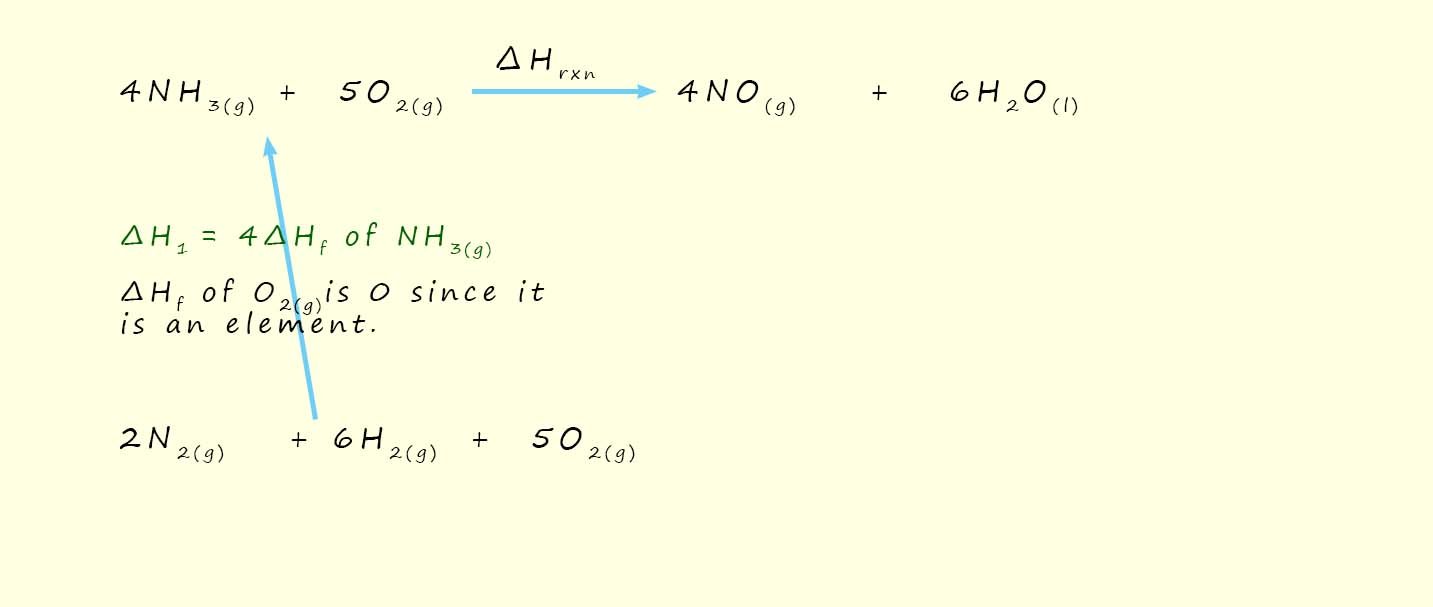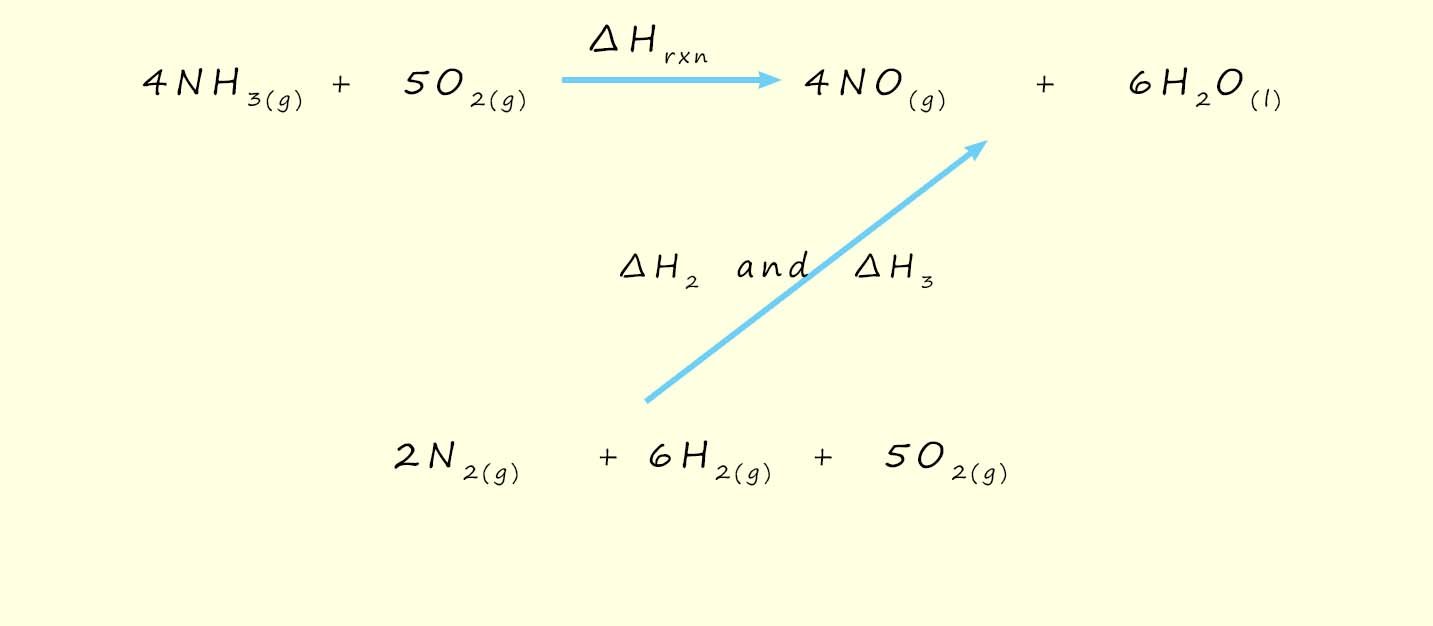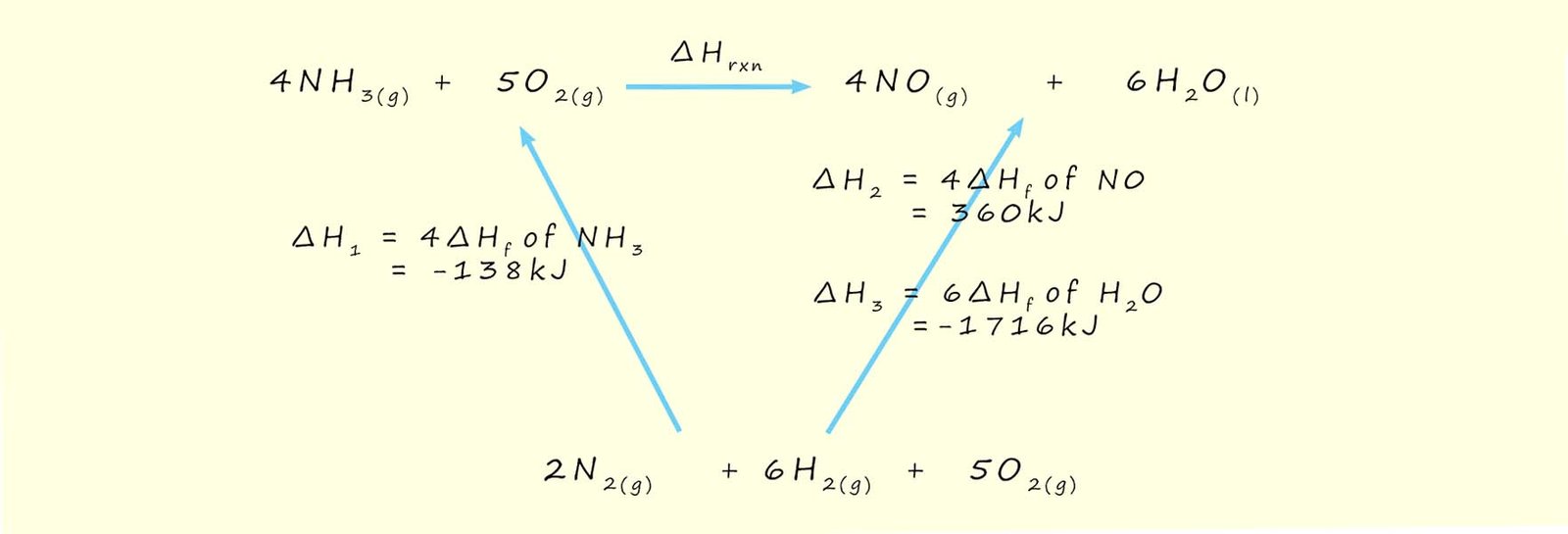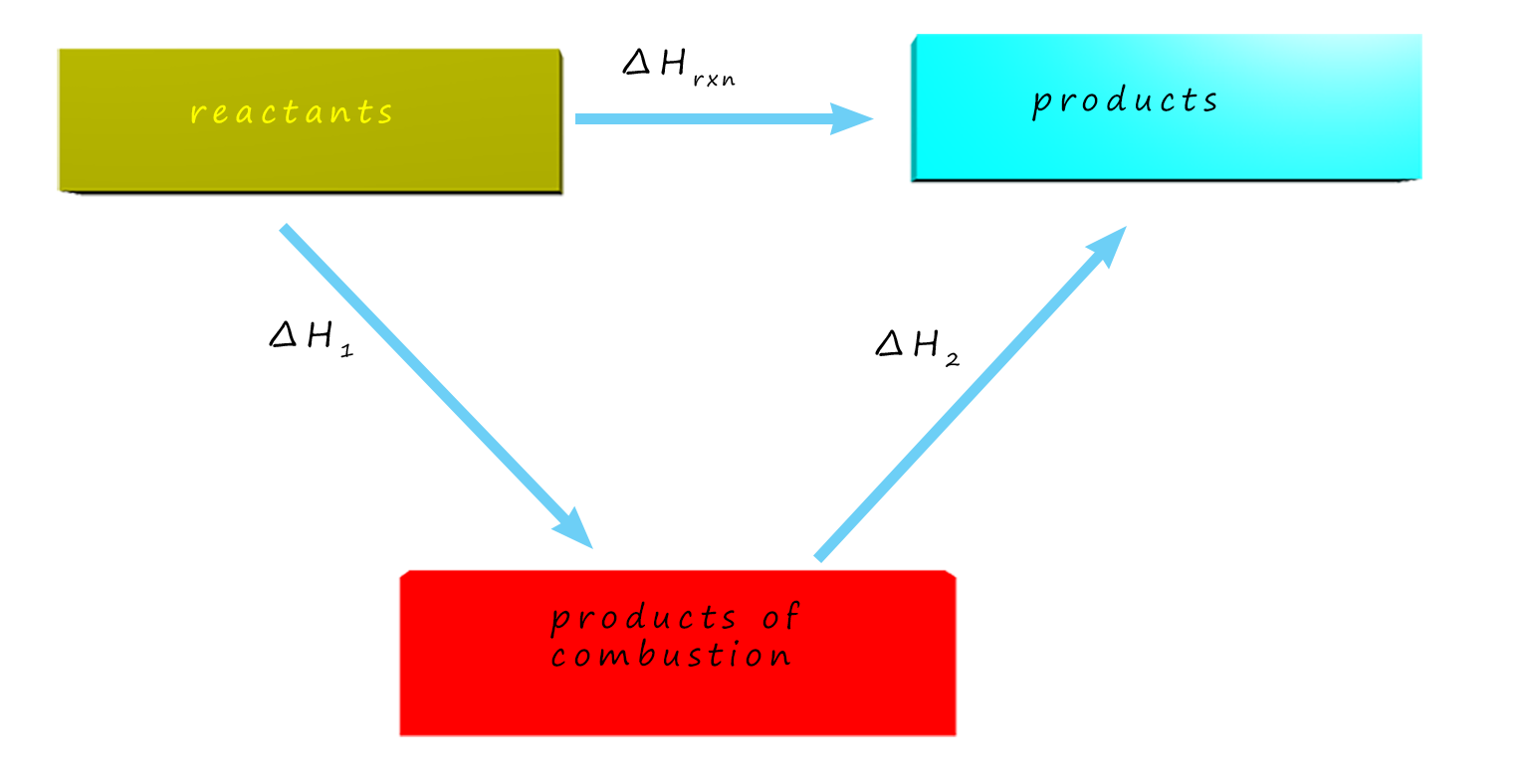Hess's Law
Many chemical reactions are difficult to carry out in the lab under normal conditions. The reasons for this are
varied but might include:
- The reaction might be very slow and take a long time to complete.
- There may be unwanted side reactions taking place
 This means that we cannot measure the enthalpy changes for these reactions directly. Luckily
we can use Hess's law to
calculate the enthalpy changes for these reactions.
This means that we cannot measure the enthalpy changes for these reactions directly. Luckily
we can use Hess's law to
calculate the enthalpy changes for these reactions.
Hess's Law is simply an extension of the law of conservation of energy;
which states that energy cannot be created or destroyed only
change from one form to another. As an example consider the image opposite. Here the change A→B is an exothermic
reaction with an enthalpy change (ΔH1) of -1000kJ.
Now imagine that for some reason the change A→B cannot be
carried out directly. However the changes A→C and C→B are possible with enthalpy changes
of ΔH2= -400kJ and
ΔH3= -600kJ. This route from A→B simply goes through an intermediate C. However the important
fact is that both reactions, the direct route
A→B and the other route through intermediate C both start and end up at the same place.
They both start at A and end up at B.
In essence this is Hess's law. Hess's law
states that:
The enthalpy change for a reaction depends only on the
initial and final states of the reaction and is independent
of the route by which the reaction occurs.
So in our example:
- The direct route A→B has an enthalpy change of ΔH1= -1000kJ.
- The indirect route A→C has an enthalpy change of ΔH2= -400kJ and C→B
has an enthalpy change of ΔH3= -600kJ.
Or we could write ΔH1 = ΔH2 + ΔH3.
That is the sum of the two enthalpy changes, ΔH2 + ΔH3 is the same as the
direct
route ΔH1. Which is just another way of saying that the enthalpy change for a reaction is equal to the sum of the
enthalpy changes for any individual steps, as long as you start and end points
are the same. That's all there is to Hess's law!
Worked examples using Hess' law
Examiners often ask you to calculate the enthalpy change for a reaction using either enthalpies of combustion (ΔcHo)
or enthalpies of formation(ΔfHo). If you are
not sure what these enthalpy changes represent then click the links to do a little research before continuing.
Using enthalpies of combustion (ΔcHo) to calculate an enthalpy change
| substance |
Enthalpy of combustion/kJmol-1 |
| C(s) |
-394 |
| H2(g) |
-286 |
| CH4(g) |
-890 |
Example 1 - Calculate the enthalpy of
formation of methane (CH4(g)) using the enthalpies of combustion given in the table opposite.
All the questions you are likely to be asked to solve are all done the same way. So follow the method below and you can't
go wrong!
Step 1 - You must write the equation for the reaction you are being asked to calculate the
enthalpy change for. In this case we
have to calculate the enthalpy of formation of methane. An equation for
this enthalpy change is given below:
C(s) + 2H2(g) → CH4(g)
To calculate this enthalpy change we have been given enthalpies of combustion data. To be able to work out the enthalpy change you need the enthalpies of combustion
of all the elements and compound present
in the equation above; a quick
check in the table shows that you have all these enthalpies of combustion.
Now all we need to do is draw a simple energy cycle using the data we have.
Some students get confused on how to start these cycles, but if you are using enthalpies of combustion;
which we are here then the cycle
goes "downwards" for the equation above. This is set out below:

Methane (CH4) is a hydrocarbon and it will burn or combust under standard conditions to form 1 mole of carbon dioxide gas and 2 moles of liquid water. Exactly the same as we have for the combustion of the reactants in the above equation. This makes sense since in a chemical reaction all we are in effect doing is rearranging the atoms, no atoms appear or disappear. So for example we have 1 mole of carbon on the reactants side of the above equation, so we will have 1 mole of carbon somewhere on the products side of the equation. The combustion of methane, which we will call ΔH3 releases 890 kJ of energy. We now have:

Using enthalpies of formation (ΔfHo) to
calculate an enthalpy change
The other type of problem you are likely to meet is where you have to use enthalpies of formation
to calculate an enthalpy change.
| substance |
Enthalpy of formation/kJmol-1 |
| NH3(g) |
-46 |
| NO(g) |
90 |
| H2O(l) |
-286 |
As before the first step is to write out the equation for the reaction you have been asked to find the
enthalpy change for.
Example 2- Calculate the enthalpy change for the following reaction using the
enthalpy of formation(ΔfHo) data in the table.
4NH3(g) + 5O2(g) → 4NO(g) + 6H2O(l)
As before in order to calculate the enthalpy of reaction (ΔrxnH) using the enthalpy of formation data provided we need to
know the enthalpy of formation (
(ΔfH) for all the substances in our equation. Looking at the table we have all the
information we need, remember
the enthalpy of formation of an element is by definition 0.
When we drew the energy cycle above using enthalpies of combustion (ΔcHo) we drew the cycle
"downwards" from our equation. This time using enthalpies of formation (ΔfHo) we
will work "upwards" towards the equation we have to calculate the enthalpy change for.
So we have:
- Step 1:Write the equation you have to calculate the enthalpy change for:
4NH3(g) + 5O2(g) → 4NO(g) + 6H2O(l)
- Step 2: Start the Hess's law energy cycle by creating an
arrow to represent the enthalpy of formation of the reactants (ΔfH). In this case we only have to do this for the ammonia (NH3) gas since the other reactant is an element, and the enthalpy of formation of an element (ΔfH) is always O. You don’t need to write the equation for the ΔfH of ammonia but here it is anyway!
N2(g) + 11⁄2H2(g) → NH3(g)
Now there are 4 moles of ammonia in the equation for need to find the enthalpy change for so we will need to multiply this equation by x4 to account for the formation of these 4 moles of ammonia, lets call this enthalpy change ΔH1. So we have:

- Step 3: As in example 1 - the elements used to form the reactants (2N2(g) + 6H2(g) + 5O2(g)
ultimately end up in the products once the chemical reaction is done, after all this is what happens in a chemical reaction, we can show this as:

Now to complete the Hess's Law cycle simply calculate the values for the enthalpy changes when the products form from the reactants as shown in the image above. This time we have to form 4 moles of NO(g) and 6 moles of water (H2O(g)) :
So we have:
1⁄2N2(g) + 1⁄2O2(g)→ NO(g)
This is the equation for the ΔfH of NO it will have to be multiplied by 4, since there 4 moles of nitrogen monoxide gas produced. Let's call this enthalpy change ΔH2.
We also form 6 moles of liquid water, an equation to show this enthalpy of formation will be:
H2(g) + 1⁄2 O2(g)→ H2O(l)
This is the equation for the ΔfH of H2O it will have to be multiplied by 6. Let's call this enthalpy change ΔH3
Putting it all together we have:

So we can say:
ΔHrxn= - ΔH1 + ΔH2 + ΔH3
Or
ΔHrxn = (ΔH1 + ΔH2 ) - ΔH1
=(360 - 1716) - (-138)
= 1218kJ
So to get from the reactants to the products we go against the arrow for ΔH1 , that is why is appears as -ΔH1 in the cycle above.
Key Points
The hardest part of getting started with a Hess's law energy cycles is
knowing where to start - remember that
if you are given enthalpies of combustion data to calculate an unknown
enthalpy change your energy cycle goes "downwards" e.g.
- Using enthalpies of combustion to calculate the enthalpy change for a reaction (ΔHrxn)

- Using Hess’s law we can say that: ΔHrxn = ΔH1 -ΔH2
If you are given enthalpies of formation data to calculate an unknown
enthalpy change your energy cycle
goes "upwards" e.g.
- Using enthalpies of formation to calculate the enthalpy change for a reaction (ΔHrxn)

- Using Hess’s law we can say that:
-
ΔHrxn = -ΔH1 + ΔH2
Or
- ΔHrxn = ΔH2 - ΔH1
Practice questions
Next


 This means that we cannot measure the enthalpy changes for these reactions directly. Luckily
we can use Hess's law to
calculate the enthalpy changes for these reactions.
This means that we cannot measure the enthalpy changes for these reactions directly. Luckily
we can use Hess's law to
calculate the enthalpy changes for these reactions. 





